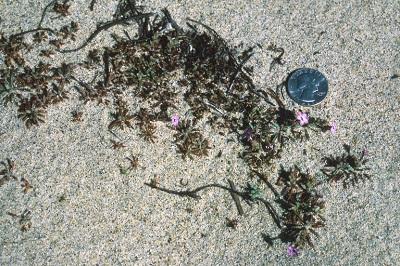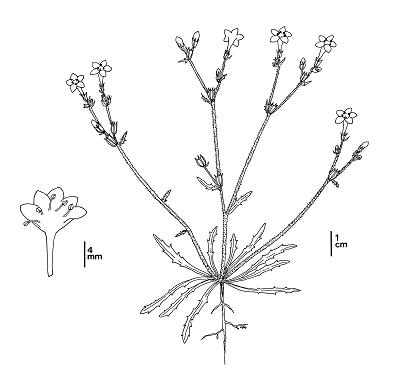Gilia tenuiflora ssp. arenaria
 Gilia tenuiflora ssp. arenaria. Photo © Susan Cochrane(opens in new tab)
Gilia tenuiflora ssp. arenaria. Photo © Susan Cochrane(opens in new tab)
 Gilia tenuiflora ssp. arenaria. CDFW Illustration by Mary Ann Showers. (Click to enlarge)
Gilia tenuiflora ssp. arenaria. CDFW Illustration by Mary Ann Showers. (Click to enlarge)
Monterey gilia is a California threatened plant species, which means that killing or possessing this plant is prohibited by the California Endangered Species Act (CESA). Monterey gilia is also listed as endangered under the federal Endangered Species Act. It is an annual herbaceous plant in the phlox family (Polemoniaceae) that blooms from March through May. It has white and purple funnel-shaped flowers at the end of long stems that grow from a rosette of leaves. Monterey gilia only grows in coastal dunes and inland maritime chaparral habitat along the coast near Monterey.
About half of the remaining populations of Monterey gilia occur on state and federal lands and the other half occur on privately-owned lands. Consistent monitoring and analysis of population recovery has been difficult because of changes in land ownership over the years and because Monterey gilia is an annual plant and goes through large fluctuations in population numbers from year to year. Additionally, the amount and timing of seasonal rainfall can significantly affect germination and growth. Surveys show that Monterey gilia is more common where there is less than 30 percent vegetative cover.
Monterey gilia is primarily threatened by development, sand mining, vehicles, recreation, and non-native plants. Herbivores such as rabbits and mice eat the plant and can decrease the survival of seedlings and adult plants. However, if the basal rosette is left intact, the plant can re-sprout with increased seed production. Habitat conversion is one of the biggest threats to Monterey gilia. The Big Sur Land Trust acquired a parcel of Monterey gilia habitat that might have been subject to development but is now protected. The Department of the Amy’s closure of Fort Ord has resulted in protection of Monterey gilia habitat at Fort Ord National Monument and in a University of California Natural Reserve; however, Monterey gilia habitat at Fort Ord is still threatened with destruction by ongoing development at the University of California Monterey Bay Education, Science, and Technology Center and elsewhere. A Fort Ord Habitat Conservation Plan to conserve and contribute to the recovery of endangered and threatened species within the former Fort Ord is under agency review.
CDFW may issue permits for Monterey gilia pursuant to CESA, and you can learn more about California laws protecting Monterey gilia and other California native plants. Populations of Monterey gilia occur in CDFW’s Central Region. More information is also available from the
U.S. Fish and Wildlife Service Species Profile for Monterey gilia.
Updated 6/29/2017